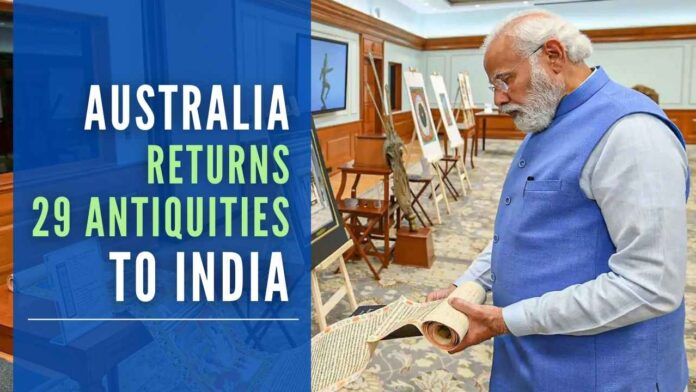
PM Modi inspects 29 antiquities returned to India by Australia
In a historic move, 29 antiquities have been repatriated to India by Australia. This move by Australia comes on the day when Prime Minister Narendra Modi and his Australian counterpart Prime Minister Scott Morrison are scheduled to hold a virtual meeting.
Earlier, while PM Modi was on a visit to Australia, the Former Australian Prime Minister Tony Abbott had returned a 900-year-old Shiva sculpture that was smuggled by disgraced art dealer Subhash Kapoor.
As per the sources, the sculptures and paintings are made up of a variety of materials – sandstone, marble, bronze, brass, and paper and come from different time periods. The earliest dating of the antiques is from 9-10 Century CE.
Other decorative objects include a 1775 painting of a young lady with an elaborate saree from Bundi in Rajasthan, a brass object from 19th Century Hyderabad, Telangana, and an 1875 art of an amorous couple from Kalighat, Kolkata, West Bengal.
The 29 antiquities belong to a large geographical region in India, ranging from Rajasthan, Gujarat, Madhya Pradesh, Uttar Pradesh, Tamil Nadu, Telangana, and West Bengal. It depicts the themes of Lord Shiva and his disciples, Lord Vishnu, and also a few from the Jain tradition.
The ‘Jain Tradition’ has an artifact showcasing the ‘Arch of a Jain Shrine’ dated 11th-12th Century made of marble from Mount Abu region. The category also includes ‘Vijnaptipatra’ — the letter of invitation to Jain monks in a picture scroll using gold and silver from the 19th Century Rajasthan.
In the ‘Worshipping Shakti’ category, the 12-13th CE idol of Durga Mahisasuramardini is seen holding the Mahisha demon by his hair, with her tongue out, and an aggressive expression throughout her face.
‘Lord Vishnu and his Forms’ represents the 12-13th Century sandstone sculpture from either Rajasthan or Uttar Pradesh of divine couple Lakshmi and Vishnu as central deities, felicitated by Brahma and Shiva on either side. The category also includes a 1720-1730 painting from Bikaner, Rajasthan, displaying Varaha rescuing the Earth Goddess, a 19th Century art of Krishna and Arjuna from the Mewar region of Rajasthan.
In the ‘Shiva and his Disciples’ category, the 9-10th Century sandstone idol is seen adorned with a ‘mundmālā’, trampling on an ‘āpasmārapurusa’, attended by a female attendant, and, is embellished with a serpent-hood crown. Visible ‘ayudhās’ represent a trident in two hands, ‘damru’, in another, skull in one, and the serpent in another. The other artifacts in this category include the 12th Century ‘Child-Saint Sambandhar’ and ‘Dancing Child-Saint Sambandar’ from Tamil Nadu, 14th Century ‘The Saint Chandikesvara’ and a Shiva and Parvati painting circa 1830-40 from Kangra, Himachal Pradesh.
Prime Minister Narendra Modi inspected these antiquities which returned from Australia.
[With Inputs from IANS]
PGurus is now on Telegram. Click here to join our channel and stay updated with all the latest news and views
For all the latest updates, download PGurus App.
- Will ‘exit India’ if forced to break encryption: WhatsApp to Delhi High Court - April 26, 2024
- Seers of Ayodhya react sharply to Rahul, Priyanka’s ‘proposed’ visit to Shri Ram Mandir - April 26, 2024
- PM Modi launches another scathing attack on Congress; says ‘Rajiv Gandhi scrapped inheritance law to save family property’ - April 25, 2024







